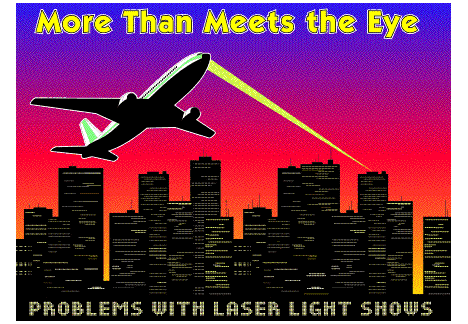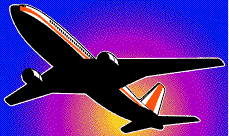![]()
Issue Number 7 : September 1995
|
|
Issue Number 7 : September 1995 |

by Marcia Patten
"Prior to reaching NANCI Intersection...we were bombarded with multicolored laser beams coming from atop the Pan Am building. This continued until we were out of the area that the laser beams were being aimed. After turning final for runway 13, the laser beams again struck our aircraft and continued to do so until we were out of their line of sight. It appears that good sense operation of laser beams is out of hand. The damage to one's eyes, not to mention loss of night vision, can contribute to an accident." (# 89425)
Such was the surprise awaiting one Captain over New York City several years ago. Recently, though, encounters with lasers have become prevalent enough to attract media attention.
Lasers--standing for Light Amplification by Stimulated Emission of Radiation--are light beams powerful enough to cut through metal, or delicate enough to perform microscopic surgery. Apart from their scientific and medical uses, lasers are being used increasingly to produce spectacular, crowd-pleasing light shows at concerts, fairs, theme parks, and casinos.
In general, commercial laser light demonstrations are regulated by the Food and Drug Administration (FDA) via its Center for Devices and Radiological Health. When a laser operator applies for a permit for an outdoor light show, the regional FAA Air Traffic Division conducts a study of the effects a light show may have upon nearby navigable airspace. The study considers many issues, including:
The FAA combines its study results with information supplied by the FDA to develop power restrictions for laser use in navigable airspace. The most explicit restrictions define a horizontal and a vertical "eye-safe distance" for each display, depending on the type and intensity of the lasers used. Exposure at any closer than this distance is deemed to be potentially injurious to pilots' or passengers' eyes.
However, there is a more widespread problem associated with laser shows, that of flash blindness. A sudden flash from a laser or any other bright light causes a spot or halo to remain at the center of the visual field for a few seconds or even a minute, rendering a person virtually blind to all other visual input. At night, a flash destroys the eye's adaptation to the dark environment; partial recovery of this adaptation is usually achieved in 35 minutes, but full adaptation typically requires 4045 minutes or more. ASRS receives many reports of flash blindness being caused by various light sources, among them: lightning strikes, searchlights, aircraft static discharges or electrical short circuits, reflections from glass high-rise buildings, and even floodlights from golf course driving ranges. A First Officer flying near Miami at night reported just such an experience:
Loss of "night vision" could be particularly dangerous for a single pilot, who has no one else in the cockpit to provide assistance while initial recovery of night vision begins.
Las Vegas, Nevada, seems to be a hotbed of laser activity. On any evening, three or four outdoor laser light shows might pierce the skies. These shows have become a major source of pilot complaints and a major recipient of careful scrutiny by the FAA Air Traffic Management office. One crew departing Las Vegas got more than the "eyeful" usually associated with The Strip:
 "[On takeoff], at approximately
500 feet AGL, a laser beam of green light struck through the right side window
of my cockpit striking my First Officer in the right eye and blinding both
he and I for approximately 510 seconds due to the intensity of the light beam.
I immediately notified the Tower Controller [who stated] that this had become
a recurring problem with the laser show coming from the top of the [hotel]
in Las Vegas. We were very fortunate, because this could have been a much
more serious situation had the laser struck myself as well as [my First Officer]
at a more direct angle, severely blinding both of us and endangering the lives
of my passengers and crew." (# 285091)
"[On takeoff], at approximately
500 feet AGL, a laser beam of green light struck through the right side window
of my cockpit striking my First Officer in the right eye and blinding both
he and I for approximately 510 seconds due to the intensity of the light beam.
I immediately notified the Tower Controller [who stated] that this had become
a recurring problem with the laser show coming from the top of the [hotel]
in Las Vegas. We were very fortunate, because this could have been a much
more serious situation had the laser struck myself as well as [my First Officer]
at a more direct angle, severely blinding both of us and endangering the lives
of my passengers and crew." (# 285091)And another pilot, 90 miles south of Las Vegas, reported:
A Society of Automotive Engineers (SAE) committee, composed of FAA personnel, aviation industry representatives and others, is addressing issues of flash-blindness and its impact on safety of flight, rather than just eye-safe distance, which already is properly controlled by FDA regulations. Among the potential solutions being studied include: further limitation of laser power (wattage), restriction of laser shows to non-flight times and non-flight airspace, additional training for laser operators, enforcement action against laser operators who violate airspace regulations, and standardization of FAA handling of laser show studies. Technical advances may provide aircraft systems that can interrupt a laser's beam before it strikes the aircraft.
At present, a pilot's best defense against laser flashes is knowing where to avoid them. The locations, dates, durations, and eye-safe distances for approved displays are published in the Airport Facility Directory (AFD) for each region. Locations of light shows that have been approved after the publication of the AFD may be available only through Flight Service Stations (FSS). A glance through some of the most recent AFDs revealed quite a list of scheduled laser light show locations. Several regions noted only a few shows, but the South West region listed ten laser shows nightly. Some are temporary during the summer, or for the duration of a fair or other event; others are listed as permanent. Air carrier dispatch or base operations offices, as well as general aviation pilots, need to be in frequent contact with the local FSSs to receive the most up-to-date information on laser show activity.
Another simple defense against laser flashes is to avoid looking at them, if possible. Just as automobile drivers are advised to avoid looking directly at oncoming headlights, one airline's safety representative has recommended, "If you see the laser coming toward you, don't look right at it."
Pilots are also urged to submit reports
of laser flash incidents to ASRS, and to the regional Air Traffic Management
officer.

| Reproduction and redistribution of ASRS Directline articles is not only permitted--it is encouraged. We ask that you give attibution to ASRS Directline, to the Aviation Safety Reporting System (ASRS), and of course, to the authors of each article. |